Sclerotinia stem rot, also known as white mould, watery soft rot, drop or blossom blight is caused by the soil-borne fungus Sclerotinia sclerotiorum (and in some cases S. minor). This fungal pathogen is found in most parts of the world and has a large host range that includes more than 400 plant species in 75 broadleaf plant families. Sclerotinia diseases are widespread throughout Canada and are favoured by moist conditions and dense crop canopies, causing damage to crops in the field and in storage.
Sclerotinia in Canola
In canola, yield losses due to sclerotinia stem rot vary from year to year, as the disease is greatly influenced by environmental conditions. If high inoculum levels are present and the crop canopy is dense, sclerotinia stem rot can cause greater than 50 per cent crop yield loss.
Sclerotinia in Other Crops
Although sunflower acreage in Saskatchewan is relatively small, sclerotinia wilt and head rot can be devastating when sunflower crops are produced in regions where other broadleaf crops are common. Sunflower plants may also develop root infections, which lead to stem breakage or head infections, which affect seed yield and quality.
Sclerotinia diseases can also affect mustard and can be a limiting factor in lodged flax and pulses grown in moister regions and wet years. Sclerotinia infection in pulses leads to stem and pod rot, crop lodging and reduced seed fill. Sclerotinia diseases have also been observed on specialty crops including hemp, borage, echinacea, coriander and caraway.
Forage legumes such as alfalfa grown for seed may also be affected by sclerotinia diseases. Blossom blight is a disease of the flowers that is caused by a combination of Sclerotinia sclerotiorum and Botrytis cinerea, leading to blossom abortion and seed yield loss.
Cereals and grasses are not susceptible to sclerotinia stem rot, which makes them an effective choice for crop rotation. However, a number of broadleaf weeds are hosts and may maintain the fungus in the soil even in non-host crop years (e.g. stinkweed, sow thistles, Canada thistle, wild mustard, redroot pigweed, knapweeds, dandelions and lambs quarters).
Vegetables affected include beans, cole crops, cucurbits, carrots, celery, lettuce, peas, radish, rutabaga, turnips, rhubarb, potatoes and tomatoes.
Symptoms
Initial symptoms of sclerotinia stem rot (and other sclerotinia diseases) appear as soft, water-soaked white to grey lesions on leaves and stems. As lesions advance they may resemble a "bull's eye" pattern of concentric rings of rotting tissue. White mould growth may be evident and spread from plant to plant via direct contact. Plant parts above the affected area will often turn pale green or yellow, wilt and eventually die. Mature lesions are bleached and are easily shredded resulting in premature ripening, stem collapse and lodging. Sclerotia are often evident inside the infected stems, or external to the infected stems in some crop types.
Sclerotinia infection may be observed as individual plants scattered throughout the field, or in moist patches in the field such as in hollows or nitrogen-rich areas. Lodged crops are more susceptible to sclerotinia infection. Rotting of stored crops, such as carrots, continues under damp, confined conditions. Pockets of rot result in complete destruction of the stored vegetable and the rot will continue to spread. Sclerotinia rot on vegetables does not produce an odour unless other secondary rotting organisms further decompose the tissues.
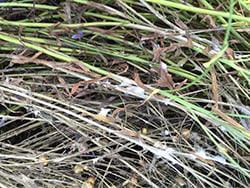 |
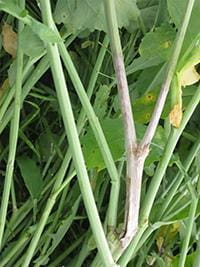 on canola |
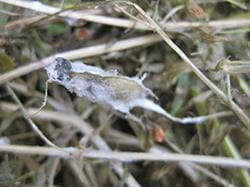 |
Disease Cycle
The sclerotinia fungus spends most of its life cycle in the soil as a hard-walled resting structure called a sclerotium (plural: sclerotia). Sclerotia consist of a melazined (black) rind surrounding a compact mass of white-coloured hyphae. Sclerotia can vary in size and shape depending on the host tissue they grow in. Sclerotia are resilient to adverse conditions and can survive in soil or plant tissue for three or more years.

In the spring, sclerotia can germinate in one of two ways. The most common way is called carpogenic germination, resulting in the formation of mushroom-like structures called apothecia (singular: apothecium). Carpogenic germination usually takes about two to three weeks and occurs under prolonged conditions of moisture at the soil surface (at least 10 days) and temperatures of 11 to 15C. This form of germination results in above-ground infections and is the main infection process in canola and pulses. Apothecia function for about five to 10 days and during that time can release as many as two million tiny air-borne spores called ascospores. The majority of ascospores land within 100 to 150 metres from their source, but spores that are picked up by wind currents can be dispersed for several kilometres. Ascospores use flower petals as a food source to establish infection. Infected petals drop down into the crop canopy and infect leaf and stem tissue.
The second type of germination is called myceliogenic germination. Sclerotia germinate by producing small hyphae that grow through the soil and directly infect host roots, resulting in damping off, root rot or basal stem infections. This method of infection is most common in sunflowers but has also been observed in other tap-rooted crops, including lentils.
Regardless of the type of infection, the fungus invades and advances within its host using cell-wall degrading enzymes and toxins that kill plant tissues. Lesion development is favoured by humid conditions and temperatures between 20 and 25C. Dry conditions slow or stop infection and lesion development. Sclerotia develop within or on diseased plant tissue and are returned to the soil with crop residue or are harvested with the seed, thus completing the disease cycle.
Disease Management
Crop rotation is not always effective because of the pathogen's large host range and its ability to survive for years in the soil as sclerotia. Also, air-borne ascospores can blow in from infected broadleaf residue from nearby fields, which further reduces the impact of a diverse crop rotation. Regardless, sclerotinia stem rot disease levels are greatest if broadleaf crops are grown consecutively. Aim for a minimum of one year, preferably three years, between susceptible crops to reduce the build-up of sclerotia in the soil.
Canola, sunflower and borage have been observed to be the most susceptible crops and have the capability of returning many sclerotia to the soil. Maintain at least three years between these crops. Volunteer broadleaf crops and susceptible weeds should also be controlled in non-host years. Cereals and grasses are effective crops to grow in a diverse rotation. Vegetable crops can also be rotated with disease-tolerant or non-susceptible vegetables such as beets, spinach, onions, or sweet corn for two to four years.
If possible, remove crop residue from the field after harvest. Sclerotia inoculum loads can also be managed using soil treatments with products designed to prevent growth of mycelium and development of apothecia/ascospores (eg. Contans biofungicide). Use crop seed that is free of sclerotia as it limits the amount of disease inoculum added to the field.
Manage moisture levels, especially in irrigated crops. Plant crops into well-drained soil. Wide, uniform row spacing and lower seeding rates may increase air movement within the crop canopy and reduce the moist soil microclimate required for sclerotia to germinate. Avoid irrigation where extended periods of high humidity occur. Irrigate early in the day, allowing plants to dry before evening. Keep the top of the soil as dry as possible as the crop matures.
High nitrogen soil levels or added nitrogen fertilizer favour sclerotinia disease by creating a lush, humid plant canopy and delaying crop maturity. It is valuable to test for soil nutrients and add only the necessary amount of nitrogen fertilizer.
Additional steps may be taken to manage sclerotinia diseases in vegetable crops. Avoid contact between vegetables and wet soil if possible (i.e: use mulches). Avoid harvesting sclerotia or rotted plant material with the crop or seed. Check for cleanliness prior to storage. Produce brought into storage can be washed with household bleach (15 ml sodium hypochlorite and 36.3 litres of water = 25 ppm). Cool the crop quickly after harvest and store at the lowest safe temperature to slow the growth and spread of sclerotinia in the harvested crop. Maintain uniform, low storage temperatures.
While there are canola varieties with sclerotinia tolerance, none have complete resistance to sclerotinia stem rot, and the host-pathogen interaction is very complex. Hybrid varieties with strong stems and a branching habit are less prone to lodging even if they are infected by sclerotinia. No other varieties of broadleaf crops have been developed with resistance.
Fungicides
As well as the cultural practices listed above, foliar fungicides are an option for sclerotinia stem rot management in some crops. Refer to the Guide to Crop Protection for a complete list of registered fungicides. Consult with the Provincial Vegetable Specialist for a complete listing of products registered for chemical control of sclerotinia disease in vegetable crops. There are no seed treatments registered for sclerotinia disease control and no products registered for control of sclerotinia disease in stored crops.
Correct application timing and method of application are critical to fungicide performance. Even crops treated with the best products may fall victim to sclerotinia diseases under extremely wet conditions conducive to Sclerotinia infection.
In canola, timing of the foliar fungicide application is critical. Scout for conditions conducive for disease during the early flowering stage and apply a foliar fungicide between 20 to 50 per cent bloom. Optimum timing will be when disease pressure is high. If disease pressure is consistent throughout flowering, the optimum time to spray will be at 30 per cent bloom. This means that the ideal time to spray is when the crop is as yellow as possible, to ensure that the majority of the petals will be protected by the fungicide.

Research on fungicide control in pulses is limited compared to work done on canola. However, research on sclerotinia stem rot (white mould) in lentils conducted by the Crop Development Centre, University of Saskatchewan indicated that sclerotinia stem rot typically occurred late in the season after the canopy has closed and so there was usually little economic response to using foliar fungicides.
Regardless of crop, always read and follow the fungicide product label and note that foliar fungicides will not be effective once symptoms are present.
To Spray or Not To Spray
Determining whether or not the risk of sclerotinia stem rot warrants a fungicide application is a very difficult decision. This decision depends on many variables including: (1) the potential yield and price of the crop, (2) the cost of the fungicide, (3) current and predicted rainfall, and (4) presence of disease inoculum, e.g. sclerotia/apothecia.
A sclerotinia stem rot checklist was developed in Sweden to assess the level of disease risk in canola. The checklist should be used shortly after first flower (when 75 per cent of the canola plants have three open flowers on the main stem). It is important to remember that the checklist is a guideline only, and sudden weather changes can unexpectedly increase or decrease disease risk. A second evaluation at 10 to 50 per cent flowering would increase the accuracy of the forecast.
| Risk Factor | Possible Answers | Risk Points |
| 1. Number of years since last canola crop? | > 6 years | 0 |
| 3 - 6 years | 5 | |
| 1 - 2 years | 10 | |
2. Disease incidence in last host crop
|
None | 0 |
| Low (1-10%) | 5 | |
| Moderate (11-30%) | 10 | |
| High (31-100%) | 15 | |
| 3. Crop density | Low | 0 |
| Normal | 5 | |
| High | 10 | |
| 4. Rain in the last 2 weeks | < 10 mm (< 0.4") | 0 |
| 10 - 30 mm (0.4 - 1.2") | 5 | |
| > 30 mm (> 1.2") | 10 | |
| 5. Weather forecast | Low chance of precipitation | 0 |
| Uncertain or variable | 10 | |
| High chance of precipitation | 15 | |
6. Regional risk of apothecia development?
|
None found | 0 |
| Low numbers | 10 | |
| High numbers | 15 | |
| Total risk points = | (_____) | |
| If risk points total 40 or higher, it is likely worth spraying. If risk points total less than 40, it is not likely worth spraying. |
||
Disease Surveys
Canola disease surveys are conducted annually in the main canola production regions of Saskatchewan to monitor sclerotinia and other canola diseases. Survey results are reported to the Canadian Plant Disease Survey. Sclerotinia incidence maps also highlight the results of the surveys.
Saskatchewan Canola Disease Survey - sclerotinia incidence by Region, 2010-2018
| Year | North East | North West | East Central | West Central | South East | South West | Province |
| Scerotinia stem rot disease incidence (%) | |||||||
| 2010 | 20.0 | 20.0 | 22.0 | 22.0 | 12.0 | 15.0 | 20.0 |
| 2011 | 11.0 | 6.0 | 10.0 | 10.0 | 2.2 | 10.5 | 9.0 |
| 2012 | 13.6 | 16.5 | 20.4 | 29.3 | 21.7 | 4.1 | 19.0 |
| 2013 | 3.0 | 1.0 | 6.0 | 8.0 | 4.0 | 7.0 | 5.0 |
| 2014 | 7.0 | 17.0 | 13.0 | 18.0 | 15.0 | 6.0 | 14.0 |
| 2015 | 8.0 | 10.0 | 5.0 | 6.0 | 7.0 | 6.0 | 7.0 |
| 2016 | 20.0 | 30.0 | 18.0 | 46.0 | 19.0 | 20.0 | 24.0 |
| 2017 | 4.0 | 5.3 | 1.8 | 2.1 | 0.6 | 1.0 | 3.4 |
| 2018 | 4.5 | 10.5 | 1.2 | 0.4 | 1.4 | 2.2 | 5.8 |
| Average | 10.1 | 12.9 | 10.8 | 15.4 | 9.2 | 8.0 | 11.9 |
|
*Potential*
Yield Loss
|
5.1 | 6.5 | 5.4 | 7.7 | 4.6 | 4.0 | 6.0 |
*Yield loss is approximately half of disease incidence; use more accurate figures based on your experience.
Apothecia Risk Assessment
Scouting for apothecia can be time consuming, but finding them is an excellent indicator of sclerotinia risk. Not finding them either means there is a lower risk of sclerotinia stem rot or the scouting was ineffective. Alternatively, a sclerotia-depot method, developed by Lone Buchwaldt and successfully used in Denmark for many years, can be used to monitor sclerotia during the growing season, with results reported on a risk map. The method was tested in Canada for the first time in the 2014 growing season and ran until the end of the 2017 growing season.
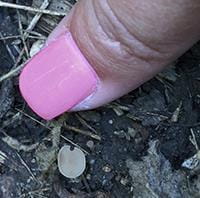 |
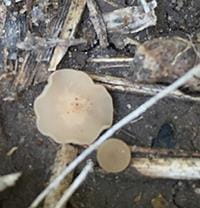 |
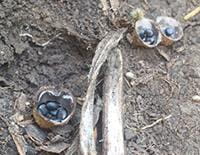 |
Canola Petal Testing
Canola petal testing methods were developed by the University of Saskatchewan in the 1980s. Petal testing is a risk assessment tool for estimating disease severity based on the percentage of canola petals (collected at the early bloom stage) infected by sclerotinia ascospores. Greater than 45 per cent of canola petals infection would warrant a fungicide application, assuming high crop density, moderate-to-high canola price, and moist conditions. While petal testing kits are no longer widely used, new options in petal testing are becoming available, including DNA testing using PCR to detect the presence of the pathogen in petals collected from the field. When using DNA-based testing of petals to assess sclerotinia stem rot risk, it is important to consider other factors that will drive the disease development in the field.
When using DNA-based testing of petals to assess sclerotinia stem rot risk, it is important to consider other factors that will drive disease development in the field.
